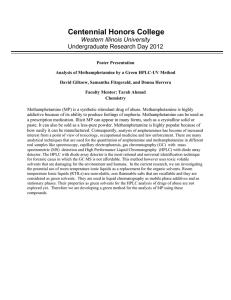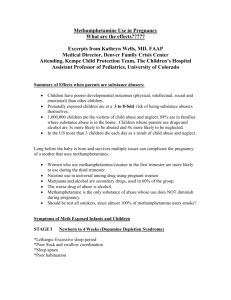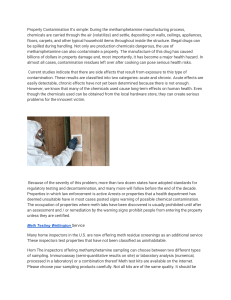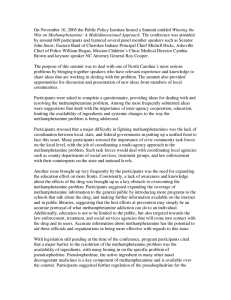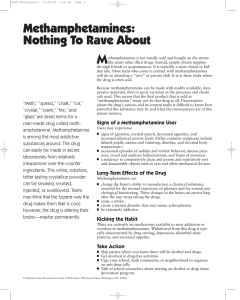Methamphetamine Neuroprotection in Traumatic Brain Injury
advertisement
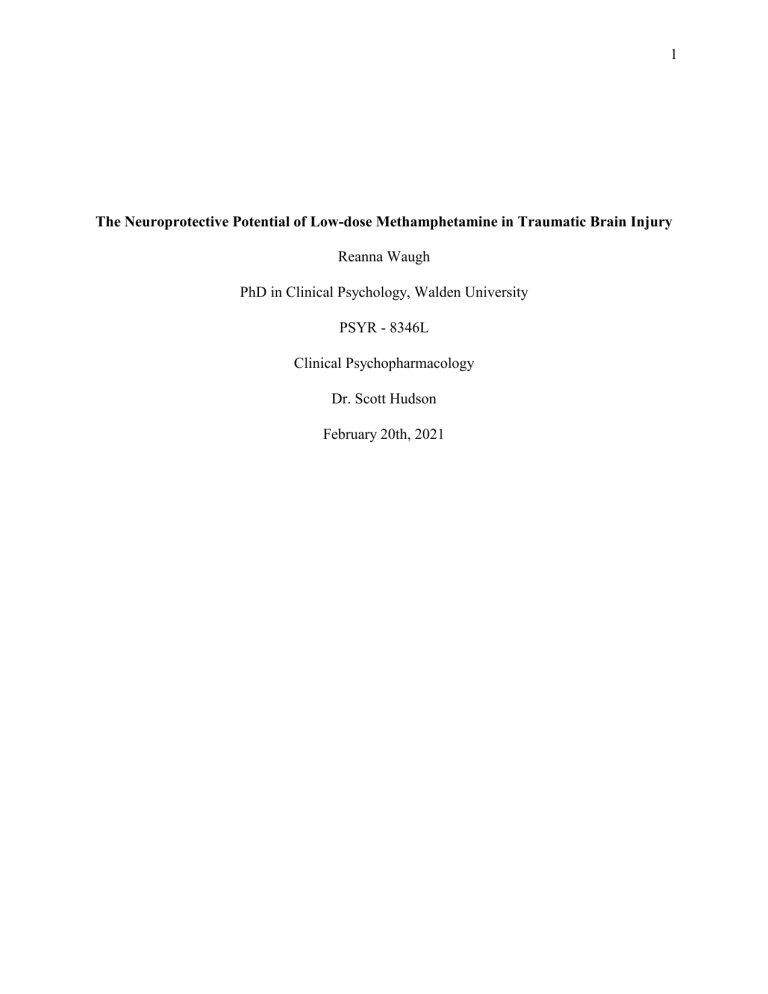
1 The Neuroprotective Potential of Low-dose Methamphetamine in Traumatic Brain Injury Reanna Waugh PhD in Clinical Psychology, Walden University PSYR - 8346L Clinical Psychopharmacology Dr. Scott Hudson February 20th, 2021 2 Abstract The many health benefits of methamphetamine in small, pharmaceutical-grade doses could considerably repair brain injury and preserve the brain in specific cases (Rau et al., 2016). Yet, the stigma against methamphetamine could significantly harm patients and hold back additional research on the positive remunerations. Initially revealed in 2008, scientists at Queen’s Medical Center Neuroscience Institute in Honolulu, Hawaii, evaluated five years of statistics on traumatic head injuries. They accidentally noticed that patients who confirmed positive for methamphetamine typically had a lower mortality rate from TBI injuries suggesting that meth could have neuroprotective benefits. Research has discovered unmistakable evidence that methamphetamine, in large repeated doses, provides neuropathology. Yet, it is distinctly noted that the characteristics and processes that produce the highly addictive side effect of the meth drug also transmit its quality as a possible therapeutic intervention for acute brain injury. 3 The Neuroprotective Potential of Low-dose Methamphetamine in Traumatic Brain Injury Methamphetamine is a psychostimulant that was initially discovered and created in 1920 (Fleckenstein et al., 2007). Since this, it has been applied to deal with attention deficit hyperactive disorder (ADHD), obesity, and narcolepsy (Advokat et al., 2018). Yet, methamphetamine has adapted a stigma of becoming a dominant drug of abuse worldwide. Research has proven that the administration of high repeated doses, methamphetamine can yield noticeable neurotoxic effects (Advokat et al., 2018). Recent analysis has discovered that low amounts of methamphetamine can provide potent neuroprotection when delivered within 12 hours after severe traumatic brain injury (TBI) in rodents (Fleckenstein et al., 1997). This discovery, including the appropriate dosing, can develop a neuroprotective effect. The continued need for additional research would further address the neuroprotective potential of methamphetamine and concentrate on the possible valuable treatments for TBI (Fleckenstein et al., 1997). Amphetamine is a psychostimulant frequently employed to deal with several disorders, including attention deficit, narcolepsy, and obesity (Preston, 2017). Plasmalemmal and vesicular monoamine transporters, such as the neuronal dopamine transmission and the vesicular monoamine transporter-2, are two of its dominant destinations (Rau et al., 2016a). Further review focuses on modern visions, recovered from both in vivo and in vitro considerations, into the molecular operations whereby amphetamine and the intimately associated compounds methamphetamine methylenedioxymethamphetamine cause monoamine, and principally dopamine, delivery (Rau et al., 2016a). These operations consist of amphetamine-induced transfer diffusion, reverse removal, and channel-like transport phenomena as thoroughly as the 4 limited base qualities of amphetamine (Rau et al., 2016a). In addition to this, studies indicate that amphetamine analogs may affect monoamine transporters through phosphorylation, transportation and trafficking, and the manufacture of reactive oxygen and nitrogen species (Rau et al., 2016b). These various mechanisms will consist of their probable indications for both amphetamine- and methamphetamine-induced neurotoxicity and the benefits involving dopaminergic neurodegenerative diseases (Rau et al., 2016b). Initially revealed in 2008, scientists at Queen’s Medical Center Neuroscience Institute in Honolulu, Hawaii, evaluated five years of statistics on traumatic head injuries (Fleckenstein et al., 2007). They accidentally noticed that patients who confirmed positive for methamphetamine typically had a lower mortality rate from TBI injuries suggesting that meth could have neuroprotective benefits (Fleckenstein et al., 2007). Research has discovered unmistakable evidence that methamphetamine, in large repeated doses, provides neuropathology (Fleckenstein et al., 2007). Yet, it is distinctly noted that the characteristics and processes that produce the highly addictive side effect of the meth drug also transmit its quality as a possible therapeutic intervention for acute brain injury (Fleckenstein et al., 2007). Amphetamines and methamphetamine are both stimulant drugs. They speed up the information traveling between your brain and the rest of your body. Methamphetamine’s chemical structure is similar to amphetamines. In rare cases, doctors prescribe legally-made methamphetamine to help treat ADHD and obesity. Amphetamine VS Methamphetamine Amphetamine is a psychostimulant frequently employed to deal with several disorders, including attention deficit, narcolepsy, and obesity (Advokat et al., 2018). Plasmalemmal and 5 vesicular monoamine transporters, such as the neuronal dopamine transmission and the vesicular monoamine transporter-2, are two of its dominant destinations (Advokat et al., 2018). Amphetamine and the intimately associated compounds methamphetamine methylenedioxymethamphetamine cause monoamine, and principally dopamine, delivery (Advokat et al., 2018). These operations consist of amphetamine-induced transfer diffusion, reverse removal, and channel-like transport phenomena as thoroughly as the limited base qualities of amphetamine (Advokat et al., 2018). Studies indicate that amphetamine analogs may affect monoamine transporters through phosphorylation, transportation and trafficking, and the manufacture of reactive oxygen and nitrogen species (Advokat et al., 2018). These various mechanisms will consist of their probable indications for both amphetamine- and methamphetamine-induced neurotoxicity and the benefits involving dopaminergic neurodegenerative diseases (Advokat et al., 2018). METH and DAT Function One mechanism whereby METH can decrease DAT function, presumably independent of transporter phosphorylation, involves reactive species formation (Fleckenstein et al., 1997). Exposure to either reactive oxygen or nitrogen species can alter DAT function. Further, METH exposure can promote formation of these reactive species (Fleckenstein et al., 1997). Among the first demonstrations of this was work by Cubells who applied METH to postnatal ventral midbrain DA neuron cultures and provided data suggesting that METH treatment rapidly alters vesicular DA sequestration that can, in turn, promote aberrant accumulation of intraneuronal DA and subsequently reactive species formation (Berman et al., 2002). The interplay between the vesicular monoamine transporter-2 (VMAT-2, a protein primarily responsible for vesicular DA sequestration) and DAT function (Berman et al., 2002). 6 Top 4 Drugs People Overdose On Fentanyl and fentanyl analogs such as carfentanil led to 19,413 deaths in 2016 (Overdose Death Rates, 2021). Fentanyl is a synthetic opioid that is 50 to 100 times stronger than morphine (Overdose Death Rates, 2021). It is commonly substituted for or mixed with heroin without the user’s knowledge (Overdose Death Rates, 2021). Users who think they are taking heroin overdose because the drug is much stronger (Overdose Death Rates, 2021). Prescription Pain Relievers These drugs, which include medications such as OxyContin, Vicodin, and Percocet, led to 19,354 deaths in 2016 (Pohl & Smith, 2012). From 2002 to 2011 there was a 1.9-fold increase in the total number of deaths from these drugs (Overdose Death Rates, 2021). But the rate has remained relatively stable since then. Heroin Heroin overdoses led to 15,469 deaths in 2016 (Overdose Death Rates, 2021). People who abuse prescription opioids often switch to heroin because it is cheaper and easier to obtain. One study found that nearly 80% of heroin users reported using prescription opioids prior to heroin (Overdose Death Rates, 2021). Cocaine Cocaine led to 10,375 deaths in 2016 (up from 6,784 in 2015) (Overdose Death Rates, 2021). Many cocaine overdoses involve other drugs. For example, in 2016, 7,263 cocaine overdoses involved cocaine and an opioid (Overdose Death Rates, 2021). Fentanyl has been increasingly mixed with cocaine and contributed to the rise in cocaine-related overdoses (Overdose Death Rates, 2021). 7 Methamphetamine is a central nervous system stimulant with the potential for therapeutic benefits. Yet, there is also a tremendous potential for abuse (Filip et al., 2010). It has a history as a popular drug of abuse is a mind-altering drug (Filip et al., 2010). The following section will review the chemistry, pharmacology, pharmacokinetics, pharmacodynamics, and toxicology of the drug and its specific effects on human performance and behavior. The review is designed to be a summary and synopsis of the forensic use of Methamphetamine. CHEMISTRY Nomenclature, Methamphetamine (C10H15N) (Structure 1), is the common name for N,α- dimethylphenethylamine, also denoted to as desoxyephedrine, methylamphetamine, phenyl isopropyl methylamine, and variability of other comparable systematic terms (Felitti, 2006). Methamphetamine is an amphetamine derivative and falls into the class of amphetamines (Felitti, 2006). The medication was initially synthesized in Japan in 1919 by Ogata, patented in 1920, and later licensed to Burroughs Wellcome, who marketed it as the anorectic Methedrine (Felitti, 2006). They use the technical nomenclature for Methamphetamine in a variety of popular terms such as meth, crystal meth, crystal, ice, speed, whiz, and crank (Rothschild, 1947). There are no specialized terms for a specific grade or chemical product, yet the terminology is most often used for illicit preparations instead of unfocused pharmaceuticals (Rothschild, 1947). Most of the over-the-counter medications sold as Methamphetamine typically contain no methamphetamine and contain ingredients such as caffeine, ephedrine, pseudoephedrine, or even cocaine, depending on local availability and laws. Chemical Properties 8 Methamphetamine exists in two isomeric forms, Dextro (d-) and Levo (l-), and these often appear as prefixes to discuss the particular isomer (Felitti, 2006). The free base (pKa 9.9) has a molecular weight of 149.24 a.m.u., and is a liquid at room temperature, and is invariably supplied and used as the hydrochloride salt (C10H16ClN, 185.74 a.m.u.) (Felitti, 2006). This has a melting point of 170–175 oC (Felitti, 2006). Unlike the hydrochloride salt of cocaine, this salt volatilizes without pyrolysis at 300–305 oC which is a temperature readily accomplished in a butane lighter flame (Felitti, 2006). Because of this, this drug is often smoked in salt form without the monotonous alteration to the base required to smoke cocaine (Felitti, 2006). Stereochemistry The configuration at the chiral center dictates the CNS activity of the product, with damphetamine (sometimes denoted as S-(+)-amphetamine) having the most significant CNS stimulant effects, 3-4 times that of the l-isomer (“The Merck Index of Chemicals and Drugs. Rahway, New Jersey: Merck and Company, Inc., 1952. 1167 p.,” 1952). The terms d- and l- refer to the dextrorotatory or levorotatory properties concerning plane-polarized light (“The Merck Index of Chemicals and Drugs. Rahway, New Jersey: Merck and Company, Inc., 1952. 1167 p.,” 1952). Pure dmethamphetamine has a [α]D25 of +14 to +20o (“The Merck Index of Chemicals and Drugs. Rahway, New Jersey: Merck and Company, Inc., 1952. 1167 p.,” 1952). Determination of the enantiomeric ratio is supportive in defining whether the drug may have initiated from licit sources, for example, l-desoxyephedrine is sold over the counter in the U.S. as the nasal decongestant, Vicks® Inhaler, or illicit or diverted sources such as d-Methamphetamine that is a legal schedule II prescription drug called Desoxyn (Rothschild, 1947). Synthesis 9 Before 1980, the prevalent methamphetamine synthesis was from phenyl-2-propanone or P2P, phenylacetone by reductive amination with methylamine over an aluminum amalgam catalyst (Liu et al., 2020). P2P was available through saleable sources with no limitations (Liu et al., 2020). Yet, it contained significant neurotoxicity that in effect made the labs hazardous to both scientists and the “meth cooks” that worked in them. The creation of the response was a racemic mixture of d- and l-methamphetamine (Liu et al., 2020). Controls placed on P2P in the early 1980s forced additional steps to synthesize this precursor, and other syntheses linking more readily obtainable preparatory materials became popular. The first is a reduction of l-ephedrine or d-pseudoephedrine over red phosphorus with hydroiodic acid (Liu et al., 2020). The enantiospecific product with either precursor is dmethamphetamine, with yields of 54–82% (Liu et al., 2020). The red phosphorus is obtained from matchbook striker plates or road flares, and although the sale of hydroiodic acid is now controlled, it can be created with little effort from iodine (Liu et al., 2020). The second method also results in an enantiospecific product, d-methamphetamine (Liu et al., 2020). It contains the lessening of the same l-ephedrine or d-pseudoephedrine precursors using either sodium or lithium metal in condensed liquid ammonia (Liu et al., 2020). They can gain the lithium from lithium batteries, sodium from an electrolytic lessening of molten sodium hydroxide, and liquid ammonia from agricultural or specialty gas suppliers (Liu et al., 2020). The substitution of phenylpropanolamine as the precursor in either synthesis yields amphetamine (Liu et al., 2020). There are apparent fire and health risks from these reagents that become noteworthy to investigators, firefighters, and others to discover a laboratory’s remains by accident. These latter two syntheses are appropriate for small-scale production. Recipes and instructions for 10 procurement are available on the Internet and have been donated to the drug’s increasing popularity. Analysis Methamphetamine is a prototypical primary drug (pKa 9.9) and is eagerly mined from biological material into organic solvents at alkaline pH (Haughey et al., 2000). It is readily soluble in chloroform, N-butyl chloride, ethyl acetate, and diethyl ether and is extracted in most common protocols designed to isolate alkaloidal and essential drugs (Haughey et al., 2000). It also readily back-extracts into acid and back into organic solvents without substantial loss (Haughey et al., 2000). Due to its volatility, it can be lost during a dry-down or evaporation step if part of the process. This loss can be evaded by adding a small amount of hydrochloric acid during the evaporation step or the addition of a less volatile “keeper” solvent such as dimethylformamide (DMF) (Haughey et al., 2000). Methamphetamine is readily analyzed by gas chromatography (GC), and this is the most popular method in use today for the analysis of Methamphetamine in biological material (Haughey et al., 2000). Its low UV absorption properties make it an unsuitable candidate for high-performance liquid chromatography (HPLC) with ultraviolet (UV) detection (Haughey et al., 2000). It has no native fluorescence and no significant oxidative electrochemical properties at low voltages. When analyzed without derivatization, as is commonly done in GC drug screening, Methamphetamine is readily eluted from most stationary phases at low temperatures (~50 oC) due to its low molecular weight basicity results peak-tailing on some stages (Haughey et al., 2000). Because of its early elution time, care should be taken in underivatized GC analysis (Haughey et al., 2000). The detector is turned initially off to allow the solvent front elution because the drug may elute before the sensor turns on (Haughey et al., 2000). Standards for this 11 drug and its major metabolite, amphetamine, should be run frequently, especially following column maintenance or GC conditions changes (Haughey et al., 2000). Its low molecular weight, the low intensity of its mass fragments in electron impact mode, and the structural similarity of many endogenous and exogenous compounds mean that the mass spectrum of Methamphetamine is not as highly characteristic as many others (Haughey et al., 2000). For example, phentermine is a structural isomer of Methamphetamine, has a very similar mass spectrum (Haughey et al., 2000). Attention should be engaged when executing the analysis of Methamphetamine to check both the retention time of this drug and its analogs and to review the mass spectra for uniformity cautiously. There is an indication that ephedrine or pseudoephedrine may be modified to Methamphetamine in the GC injection port (Brooks & Smith, 1993). A strategy containing periodate pretreatment has been depicted, which disposes of this interference (ElSohly et al., 1992). Other researchers have revealed that Methamphetamine can be demethylated to amphetamine during this periodate remedy and recommend pH 6.2 to avoid this (ElSohly et al., 1992). The Substance Abuse and Mental Health Services Administration, or SAMHSA, also compels that in standardized urine drug testing, at least 0.200 mg/L of amphetamine be current before a methamphetamine result can be reported (French, 2000). In a nonregulated environment, where this precedent is not customarily applied but where ephedrine is shown to be current in a significant surplus of Methamphetamine, there should be an accurate analysis of the strategy and data. The question of lack of selectivity of the methamphetamine mass spectrum can be resolved by derivatization (Valtier & Cody, 1995). PHARMACOLOGY 12 The amphetamines’ pharmacology is sophisticated and contains both central and peripheral processes (Haughey et al., 2000). Suggested hitherto is fundamentally concise, and an analysis of the pharmacology of neurohumoral transmission in an all-inclusive pharmacology explanation (Haughey et al., 2000). Methamphetamine is a sympathomimetic drug, suggesting that it mimics endogenous transmitters in the sympathetic nervous system by communicating with their receptors (Haughey et al., 2000). The prototypical sympathetic neurotransmitters are the catecholamines, norepinephrine, dopamine, and epinephrine, and the skeletal comparison of Methamphetamine is straightforward (Haughey et al., 2000). Specifically, Methamphetamine interacts with presynaptic receptors by aggressive antagonism and has a nominal, if any, reaction as an agonist at postsynaptic receptors (Haughey et al., 2000). CNS Effects The amphetamines’ persuasive central nervous system (CNS) triggering effects emerge by advancing the discharge of biogenic amines from their stores in the nerve terminals, and there is some corporation between specific aspects of the amphetamine experience and neurophysiological structure and chemistry (“Pharmacology-Therapeutics,” 2002). Enhanced discharge of norepinephrine from central noradrenergic neurons appears to be sufficient for the alerting and anorectic effects of the amphetamines simultaneously with dopamine release from dopaminergic nerve terminals for the locomotor prompting effects (“PharmacologyTherapeutics,” 2002). The standardized, repetitive style represented by higher doses of amphetamines is also a dopamine release component, especially in the neostriatum (“Pharmacology-Therapeutics,” 2002). More excessive amounts, dopamine release in the mesolimbic system, and intensified release of 5-hydroxytryptamine (5-HT, serotonin) in tryptaminergic neurons may be answerable for both interruptions within perception and frank 13 psychotic behavior (“Pharmacology-Therapeutics,” 2002). High-dose methamphetamine administration contributes to decreases in brain levels of the neurotransmitters dopamine and serotonin (5-HT) and minimization in the activity of the enzymes responsible for their syntheses, such as tyrosine dehydroxylase and tryptophan hydroxylase (“Pharmacology-Therapeutics,” 2002). Both acute and chronic administration of Methamphetamine in an in vitro system created a decline in the rate of dopamine and 5-HT uptake into the striatum as soon as 30 minutes after exposure to the drug (“Pharmacology-Therapeutics,” 2002). The development was reversible and lingered less than 24 hours and could not be suppressed by washing the drug out of the synaptosomes (“Pharmacology-Therapeutics,” 2002). The transporter flow came back to normal after 24 hours, but lowered again after eight days, proposing a second distinct effect, that of neurotoxicity and correlated terminal degeneration (“Pharmacology-Therapeutics,” 2002). There is an indication that other transporter structures such as norepinephrine are also involved, yet by a contrasting system, since washing residual Methamphetamine out of the cell preparations did oust the effect (“Pharmacology-Therapeutics,” 2002). Peripheral Effects Peripheral reactions of the amphetamines are more marked with the l-isomers and come principally through their α and β1 and β2 adrenergic agonist attributes (Perez-Reyes et al., 1991). Distinctive “fight or flight” reactions of Methamphetamine interceded through the α-receptors consist of mydriasis or the pupillary dilation, bronchial muscle dilation, vasoconstriction, coronary dilatation, and bladder compression (Perez-Reyes et al., 1991). The heart rate quickens, blood pressure surges, and blood glucose levels strengthen (Perez-Reyes et al., 1991). The peripheral vasculature is constricted, intensifying venous blood pressure, and cardiac output may be slowed (Perez-Reyes et al., 1991). These effects can appear in arrhythmia, despite the dose or 14 blood absorption, placing subjects with cardiovascular disease at high risk of heart attack (PerezReyes et al., 1991). Auxiliary proposes that cardiac effects may be interceded periphrastically by releasing epinephrine into the circulation and may subsidize advances in heart muscle superseding regular practice (Perez-Reyes et al., 1991). Skin tremors may flourish. In the male, ejaculation is delayed, and the strength of orgasm is intensified conjoined with the rise in libido correlated with the practice of this medicine, gives it favored notoriety as a “sex drug” (PerezReyes et al., 1991). Notwithstanding, at greater doses and in more acute handling sequences, end-users commonly fail to obtain orgasm, and enthusiasm in sexual activity is therefore reduced (PerezReyes et al., 1991). The stereoselective character of the peripheral processes of the amphetamines represents the developments and reactions experienced by the end-user. It is purposeful to a significant amount by the drug consumed nantiomeric content (Perez-Reyes et al., 1991). Endurance to peripheral developments including mydriasis may evolve, yet the severity is unduly irregular. The peripheral reactions on the heart suggest that the pharmaceutical’s enantiomeric rhythm may shape the capacity of the medicine involvement for the user and the term of the lifethreatening pathophysiological developments (Perez-Reyes et al., 1991). Route of Administration Methamphetamine can be consumed via an array of ways, and there is customarily a development superseding the outset of use, from oral ingestion that is generally in gelatin capsules or presently more often than not in small bundles of toilet tissue, or nasal insufflation, to intravenous use (Barbier, 2001). Smoking of the drug attained a demand in Asia and Hawaii in the 1980s and was linked with “Ice,” which was more generous crystals of Methamphetamine that were smoked in a pipe, much like crack cocaine (Barbier, 2001). Despite the media scrutiny 15 provided for this phenomenon, it not in any way obtained epidemic acceptance as a way of administration. It endured being inconsequential matched to the others considered (Barbier, 2001). In Seattle, the practices of administration revealed in the spring of 1998 were smoking (19%), intranasal use (36%), and IV use (44%) (Barbier, 2001). Military Use and Effects on Counteracting Fatigue As early as 1966, it was noted that the achievement intensification emerging from amphetamine practice was commonly compelling in strengthening performance in exhausting cases, comparatively to productive achievement above baseline in systematic studies (Haughey et al., 2000). The reactions of fatigue are of enormous interest to the military, especially in a combat environment. Newhouse et al. revealed the effectiveness of d-amphetamine in doses of 10 or 20 mg on reinstating baseline achievement in cases bereft of sleep for 48 hours and discovered a dose-related degree of growth. The use of amphetamines by the military is a controversy that warrants consideration, since outwardly, it may emerge at odds with debates disclosed within the abuse of Methamphetamine that would inescapably contribute to destruction (NEWHOUSE, 1989). Continually from its design in 1919, this pharmaceutical’s potential profits in a military setting have been welcomed (NEWHOUSE, 1989). It was practiced by both the Allied and Axis capacities during the Second World War to grant lengthened forced marches and to sustain troops vigilance and alert in extensive combat (Haughey et al., 2000). Military handling of the pharmaceutical to counteract fatigue has remained through to the present day. In Operations Desert Storm and Desert Shield during the Gulf War, pilots were sent “GO” pills (damphetamine, 5 mg) (Stewart, 2017). They were curbed to use one tablet every four hours to fight fatigue emerging from continued flying operations that were more than 16 hours and troop rest periods of less than six hours, and time zone interchanges (Stewart, 2017). As frequent as 16 two-thirds of the pilots flying practiced the medicines, and the developments’ assessment was virtually consistently positive, many describing that they perceived it produced safer flying operations (Stewart, 2017). Nonetheless, in comparison to regular recreational arrangements of use, the drug was carried out orally, in small split doses, under a flight surgeon’s guidance. Caldwell et al. indicated the capability of amphetamine using 30 mg in divided 10-mg doses at 4-hour intermissions to preserve helicopter pilot conduct in a flight simulator during spans of sleep deprivation that were over 48 hours without sleep were most effective. There was lowered slowwave EEG activity, advanced alertness, and stronger self-ratings of fatigue and agility. Caldwell and Caldwell typically validated these reactions in certain helicopter flights. However, the drug’s effects were less significant and did not become significant until after 24 hours of sleep deprivation. Conclusion While Methamphetamine may not be universally accepted as medication, it undoubtedly has the power to heal as quickly as it can harm. Respecting the duality of meth is arguable all the further fundamental in the challenge of a growing stimulant overdose crisis. The overdose crisis may be shifting from opioids to stimulants, including the lack of preparation for the next wave. The stigma involved causes a narrow lens where society perceives all drug issues. This makes the situation more difficult for people to make the best decisions due to fear-based perceptions that are not rational. That stigma had remained to be a significant hurdle for further research. Doctors and public-health officials will need to correct this reporting. Until then, it may be unlikely that a global pharmaceutical company would risk marketing a substance only considered to be harmful and even deadly. The most important concept to keep in mind is that 17 everything in life has the potential to kill you when taken at a level of overdose. Most substances typically don’t require a lot to do that, yet meth happens to be the unfortunate one that does. In the end, the issue may be the difference between a poison and a cure, is just the right dose. References Advokat, C. D., Comaty, J., & Julien. (2018). Julien’s Primer of Drug Action: A Comprehensive Guide to the Actions, Uses, and Side Effects of Psychoactive Drugs (14th ed.). Worth Publishers. 18 Barbier, A. (2001). NIH releases stem cell report. Trends in Pharmacological Sciences, 22(10), 501. https://doi.org/10.1016/s0165-6147(00)01879-4 Berman, S. B., Zigmond, M. J., & Hastings, T. G. (2002). Modification of Dopamine Transporter Function: Effect of Reactive Oxygen Species and Dopamine. Journal of Neurochemistry, 67(2), 593–600. https://doi.org/10.1046/j.1471-4159.1996.67020593.x Brooks, K. E., & Smith, N. B. (1993). Lack of Formation of Methamphetamine-Like Artifacts by the Monoacetates of Pseudoephedrine and Related Compounds in the GC/MS Analysis of Urine Extracts. Journal of Analytical Toxicology, 17(7), 441–442. https://doi.org/10.1093/jat/17.7.441 Caldwell, J. A., Caldwell, J. L., & Crowley, J. S. (1997). Sustaining Female Helicopter Pilot Performance With Dexedrine During Sleep Deprivation. The International Journal of Aviation Psychology, 7(1), 15–36. https://doi.org/10.1207/s15327108ijap0701_2 ElSohly, M. A., Stanford, D. F., Sherman, D., Shah, H., Bernot, D., & Turner, C. E. (1992). A Procedure for Eliminating Interferences from Ephedrine and Related Compounds in the GC/MS Analysis of Amphetamine and Methamphetamine. Journal of Analytical Toxicology, 16(2), 109–111. https://doi.org/10.1093/jat/16.2.109 Felitti, V. (2006). Goodman & Gilman’s The Pharmacological Basis of Therapeutics, 11th edition. The Permanente Journal, 10(3), 100–150. https://doi.org/10.7812/tpp/06-008 Filip, M. ł., Alenina, N., Bader, M., & Przegaliński, E. (2010). Behavioral evidence for the significance of serotoninergic (5-HT) receptors in cocaine addiction. Addiction Biology, 15(3), 227–249. https://doi.org/10.1111/j.1369-1600.2010.00214.x 19 Fleckenstein, A. E., Metzger, R. R., Beyeler, M. L., Gibb, J. W., & Hanson, G. R. (1997). Oxygen radicals diminish dopamine transporter function in rat striatum. European Journal of Pharmacology, 334(1), 111–114. https://doi.org/10.1016/s00142999(97)01175-8 Fleckenstein, A. E., Volz, T. J., Riddle, E. L., Gibb, J. W., & Hanson, G. R. (2007). New Insights into the Mechanism of Action of Amphetamines. Annual Review of Pharmacology and Toxicology, 47(1), 681–698. https://doi.org/10.1146/annurev.pharmtox.47.120505.105140 French, A. (2000). National Highway Traffic Safety Administration (NHTSA) Notes. Annals of Emergency Medicine, 35(6), 0623–0624. https://doi.org/10.1067/mem.2000.106831 Haughey, H. M., Brown, J. M., Wilkins, D. G., Hanson, G. R., & Fleckenstein, A. E. (2000). Differential effects of methamphetamine on Na+/Cl−-dependent transporters. Brain Research, 863(1–2), 59–65. https://doi.org/10.1016/s0006-8993(00)02094-1 Liu, Y., Zhu, J., Li, Q., Wang, Y., Li, Y., Chen, J., Dang, S., Chen, J., Shi, H., Xue, J., Li, W., & Wang, W. (2020). Differences in the amplitude of low‐frequency fluctuation between methamphetamine and heroin use disorder individuals: A resting‐state fMRI study. Brain and Behavior, 10(9), 1–9. https://doi.org/10.1002/brb3.1703 NEWHOUSE, P. (1989). The effects of d-amphetamine on arousal, cognition, and mood after prolonged total sleep deprivation*1. Neuropsychopharmacology, 2(2), 153–164. https://doi.org/10.1016/0893-133x(89)90018-3 20 Perez-Reyes, M., White, W. R., McDonald, S. A., Hill, J. M., Jeffcoat, A. R., & Cook, C. E. (1991). Clinical effects of methamphetamine vapor inhalation. Life Sciences, 49(13), 953–959. https://doi.org/10.1016/0024-3205(91)90078-p Pharmacology-Therapeutics. (2002). JAMA, 288(16), 2052. https://doi.org/10.1001/jama.288.16.2052-jbk1023-5-1 Pohl, M., & Smith, L. (2012). Chronic Pain and Addiction: Challenging Co-occurring Disorders. Journal of Psychoactive Drugs, 44(2), 119–124. https://doi.org/10.1080/02791072.2012.684621 Preston, J. D. (2017). Handbook of Clinical Psychopharmacology for Therapists (8th ed.). New Harbinger Publications. QuickStats: Age-Adjusted Death Rates* for Drug Overdose,† by Race/Ethnicity — National Vital Statistics System, United States, 2015–2016. (2018). MMWR. Morbidity and Mortality Weekly Report, 67(12), 374. https://doi.org/10.15585/mmwr.mm6712a9 Rau, T., Ziemniak, J., & Poulsen, D. (2016a). The neuroprotective potential of low-dose methamphetamine in preclinical models of stroke and traumatic brain injury. Progress in Neuro-Psychopharmacology and Biological Psychiatry, 64, 231–236. https://doi.org/10.1016/j.pnpbp.2015.02.013 Rau, T., Ziemniak, J., & Poulsen, D. (2016b). The neuroprotective potential of low-dose methamphetamine in preclinical models of stroke and traumatic brain injury. Progress in Neuro-Psychopharmacology and Biological Psychiatry, 64, 231–236. https://doi.org/10.1016/j.pnpbp.2015.02.013 21 Rothschild, K. (1947). THE PHYSICIANS’ DESK REFERENCE OF MEDICAL ECONOMICS. Journal of the American Medical Association, 133(2), 124. https://doi.org/10.1001/jama.1947.02880020050022 Stewart, R. W. (2017). Operations Desert Shield and Desert Storm (Part ii). International Journal of Military History and Historiography, 37(1), 58–84. https://doi.org/10.1163/24683302-03701005 The Merck Index of Chemicals and Drugs. Rahway, New Jersey: Merck and Company, Inc., 1952. 1167 p. (1952). Science Education, 36(5), 311. https://doi.org/10.1002/sce.3730360529 Valtier, S., & Cody, J. T. (1995). Evaluation of Internal Standards for the Analysis of Amphetamine and Methamphetamine. Journal of Analytical Toxicology, 19(6), 375–380. https://doi.org/10.1093/jat/19.6.375 22
